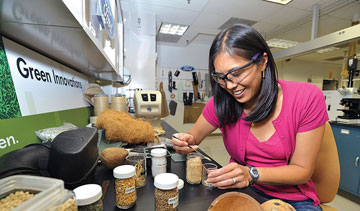
SR&ED program changes: What they are and how they work
by Kelsey Allen

Several changes in how the SR&ED program is administered could have drastic consequences for companies conducting research. Here's a look at how they may impact your company

Dr. Ellen Lee, Ford’s technical expert in materials engineering, based in Dearborn, Mich., working with soy-based foam. PHOTO: Ford Motor Co.
TORONTO—The federal Scientific Research & Experimental Development (SR&ED) tax credit program should be no secret to Canadian manufacturers.
The SR&ED program has offered an annual average of about $3 billion to Canadian companies—many of them manufacturers—which engage in research, development and commercialization.
Any company that has developed a new product, streamlined a new process, or made improvements to existing processes has likely dipped their toes into the SR&ED program, which offers tax credits for basic or applied research or technology improvement.
This is not a one-and-done program, and many companies count on these tax credits each year to fund bottom line improvements and new product development.
As such, it’s key to understand some recently implemented changes to maximize any returns from the program.
The biggest change to the SR&ED program in 2014 is the removal of capital assets from the list of qualifying expenditures.
This change will have a direct impact on companies with R&D that depends heavily on the purchasing of capital assets. Any equipment purchased for use in the testing facility or as a necessary component of the testing process falls under this category. Businesses that plan to purchase equipment for these purposes must now absorb 100 per cent of these costs.
There has also been a reduction in the portion of eligible contract payments. Often, smaller firms can’t afford to conduct their testing on-site, as many SR&ED activities require state-of-the-art facilities.
This typically leads to third-party testing in outside facilities, known as arms-length contractors. Currently, a claimant can only claim 80 per cent of the SR&ED contract amount for an arms-length contractor.
Secondly, there has also been a reduction in the general investment tax credit rate for businesses with more than $500,000 in taxable income and non Canadian-Controlled Private Corporations from 20 per cent to 15 per cent.
Effective January 2014, all SR&ED claims from these businesses will receive 25 per cent less than in past years. However, it remains an important consideration for businesses moving forward with R&D projects this year.
The CRA has modified the prescribed proxy method (PPM) for calculating a project’s overhead costs.
The PPM is an estimation of costs that a company encounters when performing SR&ED, but which are not directly related to SR&ED activities. This calculation accounts for expenditures such as office supplies, utilities, travel and training, and the wages of administrative staff providing a service to SR&ED employees.
Under PPM calculations, the claimant assumes the cost of such expenditures was a fixed percentage of the total claim amount. In contrast, the Traditional Calculation Method (TCM) requires the documentation of each individual overhead expense.
For 2014, the percentage amount used in the PPM calculation has been reduced by another five per cent, making the overheard allocation only 55 per cent in 2014. Claimants should consider whether switching to the traditional calculation method may be beneficial for them in light of this change.
As of 2014, the main SR&ED claim form— the T661—has been revised to include a new “Claim Preparer Information” section. This section requires that the claimant disclose the use of a third party in the preparation of the claim. This section includes disclosure of the third party’s business number and details of the billing arrangement between the claimant and third party. The CRA has implemented a $1,000 penalty for failure to accurately report this information in hopes of increasing accountability from SR&ED service providers.
Another T661 revision is to reorganize the document to mimic the process of project completion. The form has been reformatted to eliminate redundancy and advance chronologically through project milestones and outcomes.
Finally, in an attempt to improve companies’ ability to prepare their SR&ED claims, the CRA has introduced a First-Time Claimant Advisory Service (FTCAS). This service works with first-time claimants and offers personalized advice via a meeting with local CRA SR&ED staff at the claimant’s business.
First-time claimants should note that the FTCAS is mandatory if requested by the CRA. Claimants should therefore be prepared for a visit from CRA staff if they are filing their first SR&ED claim.
Preparation of SR&ED claims is an intensive process that requires attention to detail and extensive knowledge of program parameters. It is therefore of the utmost importance that claimants, both new and seasoned, remain up to date on program updates that have the potential to greatly impact their business. However, this diligence is not in vain. The SR&ED program offers substantial rewards for the effort put in by their applicants in the form of increased cash flow and, consequently, opportunities for growth.
Kelsey Allen is a Sales/Marketing Analyst for NorthBridge Consultants, a Cambridge, Ont.-based engineering consultancy that helps business owners and executives process SR&ED program and other government grant applications